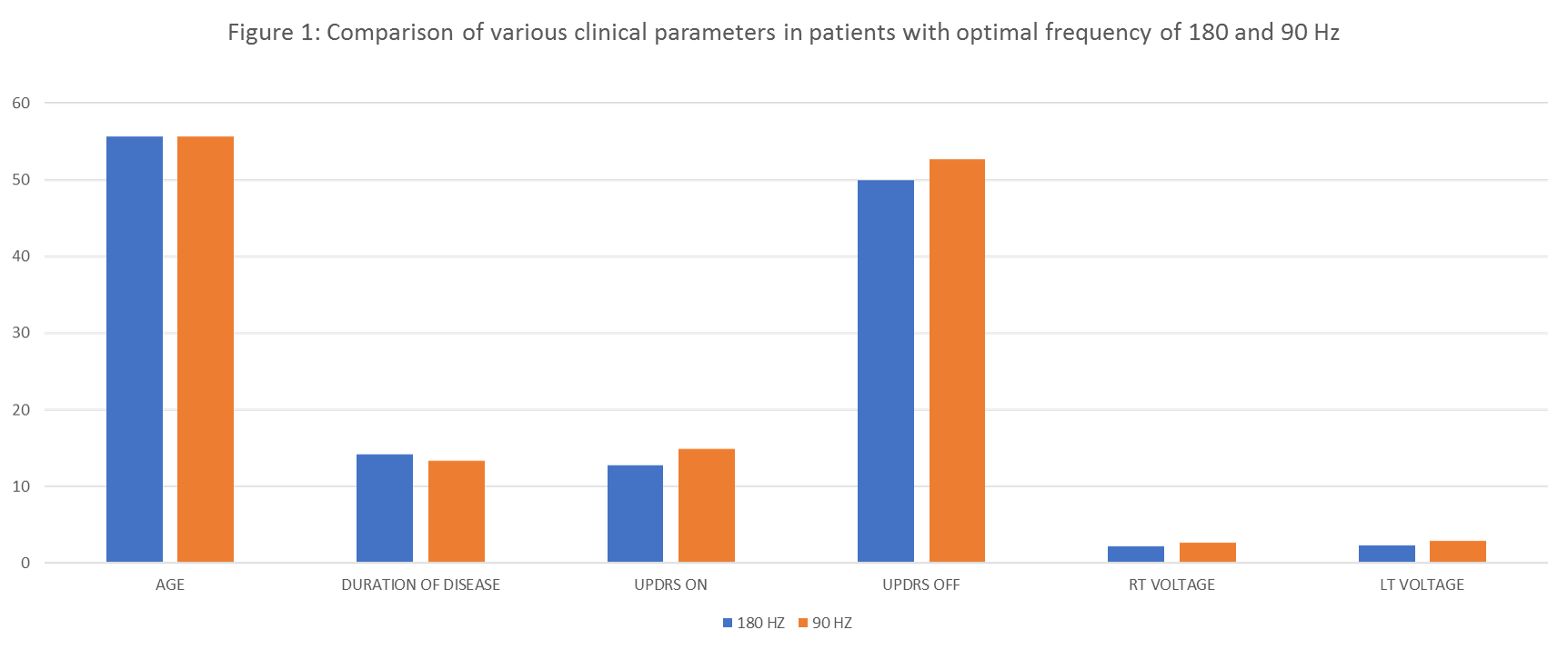Session Information
Date: Monday, June 5, 2017
Session Title: Surgical Therapy: Parkinson’s Disease
Session Time: 1:45pm-3:15pm
Location: Exhibit Hall C
Objective: To evaluate effect of different frequency settings of subthalamic nucleus deep brain stimulation (STN DBS) on gait with and without dual tasking in PD patients.
Background: Gait disturbances and freezing episodes are common in advanced Parkinson’s disease (PD) and worsen with dual tasking. STN DBS is an effective therapeutic option for improving motor symptoms in PD but its impact on gait disturbances is unclear. Studies suggest that changing frequency parameters -especially lower frequencies improve gait parameters.
Methods: Forty PD patients post STN-DBS patients with gait disturbances were included. All patients were on constant neurostimulation parameters and dopaminergic medication for a month before evaluation. Gait parameters were analyzed in medication “on” and device “on” state, at four frequencies 180,130,90,60 HZ and device “off” medication ‘on’ state. Gait was analyzed using Stand-walk-sit(SWS) test and freezing of gait (FOG) scales. Completion time, number of steps, number of freezing episodes were analyzed in SWS test. Effect of dual tasking on gait was analysed using FOG score. Wilcoxon signed rank test was used to analyze various parameters at different frequencies.
Results: Forty PD patients on neuromodulation were studied, out of which 29 were male. Average mean age was 55.45 + 10.76 years. Mean duration of disease was 13.13 + 6.41 years. Mean duration after surgery was 3.58 + 2.4 years. Thirty eight patients showed significant improvement in gait at a single frequency, which was different for each patient while two patients showed optimal response at two frequencies. In SWS test ,17 (42.5%) patients had good response at 180Hz, 6 (15%) patients at 130Hz,14 (46.7%) patients at 90Hz, 5 (12.5%) patients at 60Hz.[table 1] Total FOG scores and subscores based on dual task also improved at similar frequencies.There was a statistically significant improvement (p value <0.0001) in all gait parameters including dual tasking at best frequency in comparison to device “off” and 130 Hz. [table 2] The optimal frequency was independent of any demographic parameters, disease severity or duration or other stimulation parameters.[figure 1]
Conclusions: Optimization of frequency setting for each patient can improve gait even with a cognitive load. Both higher and lower frequencies may be beneficial and needs to be individualized.
To cite this abstract in AMA style:
R. Borgohain, R. Kandadai, R.P. Peddisetty, J. Kovvuru, S.S. Meka, R. Alagolu, M. Kannan. Optimising STN-DBS frequency parameters for improvement of gait with dual tasking in PD patients [abstract]. Mov Disord. 2017; 32 (suppl 2). https://www.mdsabstracts.org/abstract/optimising-stn-dbs-frequency-parameters-for-improvement-of-gait-with-dual-tasking-in-pd-patients/. Accessed December 13, 2025.« Back to 2017 International Congress
MDS Abstracts - https://www.mdsabstracts.org/abstract/optimising-stn-dbs-frequency-parameters-for-improvement-of-gait-with-dual-tasking-in-pd-patients/



